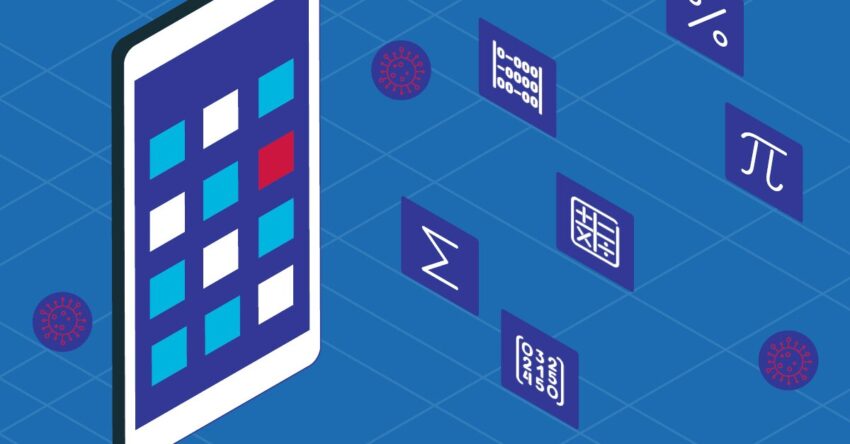
This previous spring, Dawne Coker discovered herself dressing up like her grandmother and baking cookies on digicam, all for the sake of math.
Coker, a Okay-5 tutorial coach in Cumberland County colleges in North Carolina, was looking for a strategy to exhibit the real-world relevance of measurement and fractions to third and 4th graders throughout digital studying. Digital instruments, like Khan Academy, labored properly for ability apply and procedural fluency, however youngsters have been having hassle making the soar to making use of these expertise in context, she mentioned.
So Coker began a series of YouTube videos to elucidate the “why” for classes—together with one during which she pretended to name her grandmother to ask for a cookie recipe, which led to Coker explaining the distinction between weight and capability. When colleges first went digital final spring, lecturers in her district launched and mentioned ideas utilizing Coker’s movies, and solely then despatched youngsters off to apply the mathematics expertise concerned in digital applications. It’s a way Coker is now phasing into the district’s new digital academy, the place she’s educating this 12 months.
Deciding how and when to combine new tech into math instruction is an ongoing negotiation for a lot of lecturers, notably as they transfer this 12 months right into a extra structured distance studying setting than that of the spring. It’s an particularly thorny process for lecturers of the youngest learners. “In the event you take a look at what efficient educating practices in actual stay school rooms appear to be for kindergarten and first youngsters—there’s a whole lot of tangibles, there’s a whole lot of dealing with issues and exercise. You symbolize a whole lot of the mathematical concepts in actual contexts,” mentioned Alison Clark-Wilson, a principal analysis affiliate at College School London’s Information Lab. Adapting these hands-on actions to work on a display is usually a problem.
There may be some proof that practice-focused apps can construct fluency in primary foundational expertise, like recognizing numbers and amount, mentioned Shayl Griffith, an assistant professor at Florida Worldwide College in Miami. A recent review paper published in the journal of Pediatrics by Griffith and her colleagues discovered that using math apps was linked to greater early math skills.
However she added that there are lots of applications accessible that haven’t been examined. “College districts and even dad and mom at residence are going to be getting access to applications and video games that don’t have the proof behind them but,” Griffith mentioned.
This info hole implies that the trainer’s position is very necessary in evaluating and integrating new tech, mentioned Adam Dubé, an assistant professor and the director of the Expertise, Studying, and Cognition Lab at McGill College in Montreal. “They are often the one who has the understanding of arithmetic, the understanding of pedagogy, after which they’ve the flexibility to decide on,” he mentioned.
Designing New On-line Protocols
A lot of the expertise that lecturers have entry to throughout distant studying is content-agnostic, like Google slides. On this format, there are three driving questions, mentioned Theresa Wills, an assistant professor of arithmetic schooling at George Mason College in Fairfax, Va.: What would you do within the face-to-face setting? Are you able to do it on-line? And may you do it higher on-line?
Which Digital Math Packages Are Lecturers Utilizing?
This October, the EdWeek Analysis Heart requested Okay-5 lecturers, elementary principals, and district leaders who oversee elementary math which digital curricula and applications they have been utilizing to show math remotely throughout the pandemic. Under are lists of the suppliers educators mentioned they turned to, and the place relevant, the top-cited program from every writer.
CORE PROGRAMS
- Houghton Mifflin Harcourt, 15% (GO Math!)
- Nice Minds, 12% (Interact NY/Eureka Math)
- Curriculum Associates, 10% (i-Prepared)
- Savvas, 9% (enVision Arithmetic)
- IXL Studying, 6%
SUPPLEMENTAL PROGRAMS
- IXL Studying, 19%
- Khan Academy, 11%
- Curriculum Associates, 11% (i-Prepared)
- Renaissance, 8% (Freckle)
- Dreambox Studying, 6%
- Prodigy, 6%
Supply: EdWeek Analysis Heart survey, 2020
For instance, she mentioned, lecturers in a bodily classroom would possibly ask their elementary faculty college students to indicate their work on particular person whiteboards after which maintain them as much as share out to the group. This doesn’t work as properly on a video name because it does within the classroom, Wills mentioned. It’s more durable to see what college students have written in a full-class view, and it requires all college students to be on digicam.
As an alternative, Wills remodeled the routine into a brand new on-line protocol. A desk of editable squares on a Google slide, one sq. for every pupil, now stands in for 2 dozen or so whiteboards. Youngsters can then kind their solutions into the field, the place different college students and the trainer can see it clearly.
Lecturers also can use digital blocks, counters, and different instruments to bodily symbolize numbers, mentioned Chrissy Newell, a coach at Desmos, an organization that provides free math software program.
A number of the on-line instruments are extra constrained, she mentioned—youngsters can’t get off process and use base 10 blocks as in the event that they have been Legos, for instance. “Much less freedom would possibly truly be extra useful for truly connecting it to the mathematics,” Newell mentioned. Lecturers also can simply report and replay college students’ representations.
Nonetheless, a constrained setting has its personal downsides. A web based set of blocks would possibly routinely break a base 10 block into 10 ones, taking away a chance {that a} pupil would have within the classroom to do the counting herself. How helpful—or how a lot of a barrier—these options are will rely on the targets of the lesson, Newell mentioned.
Integrating Digital Packages
Outdoors of those instruments, there’s a constellation of applications, video games, movies, and apps accessible to lecturers—each by curriculum suppliers and mainstream industrial distributors, just like the Apple app retailer.
If lecturers wish to assign apps or video games to be used outdoors of synchronous lessons, it’s necessary that they troubleshoot prematurely, mentioned Ann LeSage, an affiliate professor of math schooling at Ontario Tech College in Canada.
“You need to play it for much longer than you assume is critical, and you need to make a great deal of errors, like your youngsters will make,” she mentioned.
Lecturers also needs to take into consideration how the sport play or program use matches into their tutorial plan as a complete, mentioned Wills. “It’s an important information level to see the place youngsters are,” she mentioned, which lecturers can then use to develop acceptable interventions for college students who want extra help.
However not all video games, apps, and applications are created equal. Whereas some are designed with enter from researchers and aligned to curriculum requirements, others are made by programmers with little schooling background, mentioned Dubé.
Dubé and colleagues at McGill evaluated the top 90 math-related educational apps in the Apple App Store and located that many didn’t embody info that might assist lecturers and households consider high quality, like whether or not researchers have been consulted within the design or whether or not the app was aligned to any curriculum or instructional philosophy.
Dubé holds that internet hosting platforms, like Apple, must be doing extra to judge and label instructional applications. For now, although, it’s principally educators making these judgment calls. Consultants within the discipline instructed 4 concerns for lecturers who need to complement their educating with digital instruments.
1. Perceive limitations
Completely different apps help completely different sorts of mathematical considering and completely different moments within the studying course of, mentioned Immaculate Kizito Namukasa, an affiliate professor of arithmetic schooling at Western College in Ontario.
Some are supposed to introduce ideas; others solely provide apply issues for ideas assumed to have already been taught. Some are gamified, whereas others provide a “sandbox” setting, Namukasa mentioned, that permits for self-directed exploration.
There’s proof that apps can enhance college students’ capability to sort out specific sorts of issues or approaches to fixing them, mentioned Dubé. But it surely’s not clear that apps can enhance mathematical capability typically, outdoors of the precise areas they aim, he mentioned. For that purpose, he mentioned, lecturers ought to persist with applications which might be intently aligned with the targets of their class.
2. Search for scaffolding and suggestions
Properly-designed apps don’t simply inform college students whether or not they’ve gotten a solution proper or improper, however provide “progressive hints and scaffolding that may enable the kid to reach on the proper reply,” Griffith mentioned. That is necessary for studying, but in addition for protecting youngsters from disengaging, she mentioned.
One of the best platforms can inform when a child is in a “cycle of wrestle,” frequently placing in improper solutions even with help, mentioned Clark-Wilson. These platforms can then transfer the scholar on to one thing else and make an observation for the trainer that the kid wants extra tutorial help.
Consultants additionally agreed that apps ought to enable for college students to begin at completely different ranges relying on their skills, and to degree up, accessing progressively tougher duties as they exhibit understanding.
3. Prioritize genuine engagement
It’s necessary that math content material is built-in into the gameplay, mentioned Dubé. He highlighted DragonBox Algebra, a pre-algebra app designed for elementary-age youngsters, for example of this design.
The app asks gamers to maneuver bins across the display so as to steadiness an equation, and a participant “wins” as soon as the equation is balanced. “The sport’s mechanics are the mathematical considering,” he mentioned.
Against this, when apps embody unrelated mini-games as rewards or breaks, it will probably distract youngsters and switch their focus away from drawback fixing, Dubé mentioned.
4. Consider usability
Particularly for very younger college students, touch-screen responsiveness is necessary, mentioned LeSage. Youngsters might not be as correct of their pointing and dragging because the adults designing the expertise, she mentioned. This could have tutorial ripple results, if the app information a improper reply for a pupil who is aware of the fabric however can’t press the suitable buttons. “When the kid is being restricted due to a design flaw within the tech, it turns into unusable,” she mentioned.
















